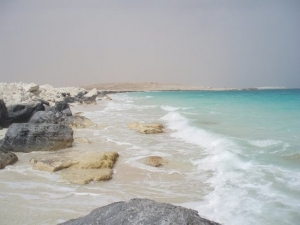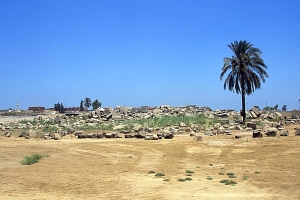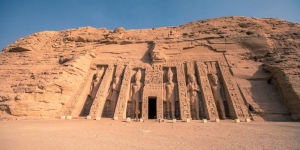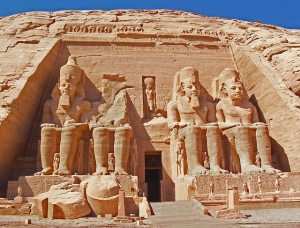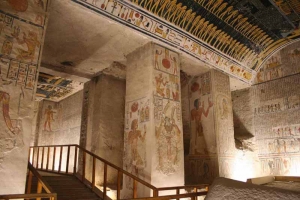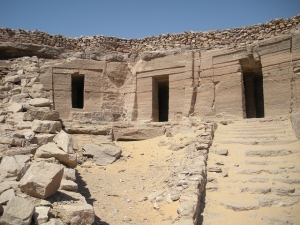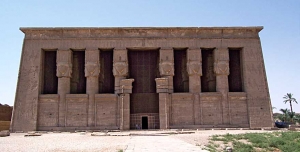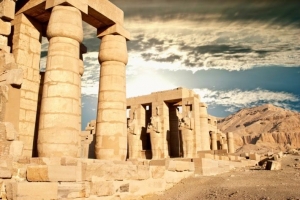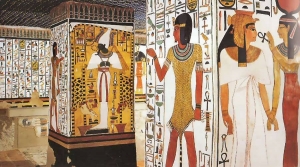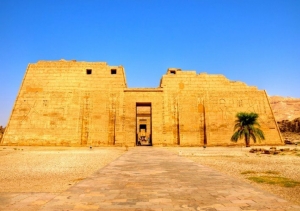+2 0122-345-3028
This email address is being protected from spambots. You need JavaScript enabled to view it.
Super User
El Alamin
El Alamin
El Alamein is most notable as the place where the Allied forces of WW II gained a decisive victory of the Axis forces.
Today, the village located about 66 miles east of Alexandria is mostly a port facility for shipping oil.
However, it was once described by Churchill as having the best climate in the world.
There are several hotels and a beach resort nearby.
There is also a war museum with collectibles from the Battle of El Alamein and other North African battles.
The Museum houses specifmens of World War II weapons, as well as busts of the generals who planned the battle at Al Alamein.
Other displays show collections of uniforms and memorabilia. There are also detailed maps and charts showing troop deployment.
The only historical interest in this village would be related to WW II, and includes an Italian and German military cemeteries on Tell el-Eisa Hill just outside of town.
Marina Ruins-Alamein:
An ancient city discovered in 1985, it comprises temples, tombs baths and nobles' houses, from the Graeco-Roman period. It is the largest archaeological city after Alexandria.
The British Cemetery Thousands upon thousands of rock-hewn tombstones stand straight rows amidst a fenced garden.
The Italian Cemetery:
It is a high tower fort standing on a high hill. The walls of the building are covered with marble.
The German Cemetery:
It is a fortress like memorial that was built on a high overlooking the sea.
Behbeit-Hagar
Behbeit-Hagar
South West of the Provincial capital Al-Mansura (in the northern delta) lies Behbeit el-Hagar .It holds the impressive remains of a shrine to the goddess Isis, as can be seen from the names of the location in classical antiquity, Iseum or Isidis Oppidum.
The Arabic name for the village, Behbeit, still contains the pharaonic name Hebyt. The temple now lies in ruins but the complex (1170 X 680 feet or 360 X 210 metres) is enclosed by a great wall built of unfired Nile mud tiles, while the temple itself covered an area 260 X 178 feet (80 X 55 metres). The temple building has totally collapsed, probably due to an earthquake, and now the visitor finds only a confusion of granite blocks and other architectural fragments.
The Temple of Isis
Ptolemaic period, 3rd century B.C
Relief block showing Ptolemy II
The shrine to Isis may well have been erected to replace an older site dating from the Saitic period (Twenty-sixth Dynasty). Nectanebo II of the Thirtieth Dynasty is known to be the first ruler who built in Behbeit, but his building was never completed owing to the Persian invasion in 343 B.C. So it was left to the two early Ptolemaic rulers, Ptolemy II Philadelphos (282-246 B.C.) and his successor Ptolemy III Euergetes I (246-222 B.C.) to decorate the temple with reliefs. They are all in hard stone, including black and red granite, and their quality is outstanding. The ritual shown here depicts Ptolemy II (on the right) handing the god Osiris a pectoral (a decorative breastplate) and a necklace. The god is not shown here in the form of a mummy; he is entirely anthropomorphic, with an Atef crown over his wig.
Wall Fragments in the Sanctuary Area
More recent studies have utilized the great variety and quantity of the surviving frag- ments of the building, like wall blocks, parts of columns, concave molding and the bases of stairways to reconstruct the ground plan of the shrine. At present, however, there are no plans to rebuild the temple, for that would require the blocks that were removed in the 19th and 20th centuries and are now scattered through- hout the world in various collections to be reunited. The temple had a plain façade, behind which stretched a great columned hall with Hathor columns of Aswan granite. Then the axis line led into the barque sanctuary for the main divinities Isis and Osiris;; this was enclosed in a wreath of chapels. The most important scenes on the long w alls of the sanctuary show the Ptolemaic King (wearing the crown of Upper Egypt) burning incense before the sacred barque of Isis, the ˝?goddess of Hebyt˝?;; her head, with cow's horns and the disc of the sun, has survived here.
The Nile ـ The Lifeblood of Egypt
The Greek historian Herodotus (5th century B.C.) called the Nile ˝?the father of Egypt, ˝? and one must agree that he was right. For it is only the oasis created by the flooding of the Nile with its broad delta that enabled a viable agri- culture to evolve and provide food for the people. The Egyptians called their land ˝?Kemet, ˝? the black land, in reference to the dark mud, rich in minerals, that were deposited every year when the water retreated after the flood. The Nile floods were a blessing and a curse at once, for they could vary greatly in depth. Depending on the rainfall in the Ethiopian uplands, the level of the floods in Egypt (from August to November) could vary by several metres. lf it was too low there would not be enough arable land to feed the people, and if the waters rose too high they caused catastrophic destruction. Egypt's dependence on the Nile, which is the second longest river in the world et 4,160 miles (6,670 km),
Is also evident in the names given in the texts for the three periods into which the year was divided, the floods, the season of crop sowing and the harvest. The river was wor- shipped as a god under the name Hapy. He is depicted as a fat man with breasts like a Woman, physical features that clearly express the idea of fertility and good care. He often appears on temple reliefs as the bringer of gifts, bearing a plate of offerings in his hands. Among his many additional names Hapy is referred to as the one "flooding the two lands with life-giving water" and even "Wet nurse of the whole land" or simply as "the river" The nature and importance of the god was also celebrated in a great hymn from the time of the Middle Kingdom. The high esteem in which the god and his gifts were held is evident in the words "One does not get drunk on silver, and one cannot eat lapis lazuli. But barley is the food of life "Therefore, since the Old Kingdom, in virtually every temple of the country a representation of Hapy could be found, often together with other fecundity deities. In their myths the Egyptians put the sources of the Nile at the southern frontier of their kingdom, south of Elephantine and not far from the first cataract. The Egyptian guide to Herodotus also referred to this when he told the Greek historian that "the sources of the Nile spring forth amid the hills from a bottomless depth, and one half of the water flows northwards to Egypt while the other flows south to Ethiopia."
Valley of the Queens
Valley of the Queens
The Valley of the Queens is located on the West Bank at Luxor (ancient Thebes). There are between 75 and 80 tombs in the Valley of the Queens, or Biban al-Harim. These belong to Queens of the 18th, 19th and 20th Dynasties.
Examples of the most important and preserved tombs:
The Tomb of Queent Titi (Tomb 52):
She is probably the queen of a 20th Dynasty. She is depicted with the sidelocks common to the Egyptian young of the period and in the presence of the gods Thoth, Atum, Isis and Nephthys. In the next chamber the queen is shown making offerings to Hathor the cow, and in the last chamber the gods Neith, Osiris, Selquit, Nephthys and Thoth.
The Tomb of Nefertari (Tomb 66):
One of five wives of Ramesses II, Nefertari was his favorite and the tomb here is one of the most beautiful in Egypt. The tomb is completely painted with scenes though out. In most of these, Nefertari, known as 'the most beautiful of them', is accompanied by gods. She is usually wearing a golden crown with two feathers extended from the back of a vulture and clothed in a white, gossamer gown. Be sure not to miss the side room where one scene depicts the queen worshipping the mummified body of Osiris. Near the stairs to the burial chamber is another wonderful scene with Nefertarti offering milk to the goddess Hathor.
Valley of the nobles
Valley of the nobles
The Tombs of the Nobles actually comprises a number of distinct areas on the West Bank at modern Luxor (Ancient Thebes). These areas mostly lie in five different regions.
The tombs at the Valley of the Nobles are much smaller and display different drawings than those found at the tombs of the Valley of the Kings.
No scenes of the journey to the "Afterworld" are found.
Instead, detailed pictures of a noble's daily life during the New Kingdom are depicted: agricultural scenes, hunting and fishing scenes, festivals and ceremonies, musicians and dancers, maids and servants, craftsmen and artisans.
Here one finds some of the most beautiful private tombs on the West Bank.
Rekhmire
The vizier under Tuthmosis III and Amenhotep II was responsible for taxation, justice and foreign policy. The reliefs in his tomb depicts tribute being brought to Egypt, a procession of African beast and goods and Rekhmire's coronation a vizier.
Sennefer
Sennufer was mayor of Thebes and overseer of the gardens of Amun during the reign of Amenhotep II. The antechamber of his tomb is decorated with reliefs of grape arbors.
Menna
Hunting and fishing scenes adorn the chambers of this 28th dynasty estate inspector's tomb.
Nakht
This tomb contains well preserved reliefs of everyday country life.
Ramose
Ramose was governor of Thebes during Amenhotep IV's reign. Work was begun on this impressive tomb in the classical Egyptian style, but on into the tomb, changed to the Amarnan style. This was because Amenhotep IV had become Akhenaton. When Akhenaton went to Amarna, Ramose followed, thus leaving the tomb unfinished.
Userhat
The royal scribe and tutor decorated his tomb with hunting scenes and barbers cutting hair.
Khaemhat
The royal scribe and granary inspector's tomb bears reliefs of harvests, unloading of boats, a market scene, and cattle herds. Of interest is a relief of a complete set of instruments employed in the Opening of the Mouth ritual.
Valley of the kings
Valley of the kings
The king's formal names and titles are inscribed in his tomb along with his images and statues. Beginning with the 18th Dynasty and ending with the 20th , the kings abandoned the Memphis area and built their tombs in Thebes. Also abandoned were the pyramid style tombs.
Most of the tombs were cut into the limestone following a similar pattern:
three corridors, an antechamber and a sunken sarcophagus chamber.
These catacombs were harder to rob and were more easily concealed.
Construction usually lasted six years, beginning with the new reign.
The text in the tombs are from the Book of the Dead, the Book of the Gates and the Book of the Underworld.
The Valley contains 62 tombs to-date, excavated by the Egyptologists and archaeologists from many countries. Not all of the tombs belonged to the king and royal family.
Some tombs belonged to privileged nobles and were usually undecorated.
Not all the tombs were discovered intact, and some were never completed.
With the increasing tourism, urban and industrial growth, pollution, and rising groundwater, the tombs have suffered over the decades.
Today their access is rotated, so that a smaller number of tombs are open at one time, and even then, many of the decorations and walls can only be seen behind glass.
Examples of the most important and preserved tombs:
Ramesses IV:
Three white corridors descend to the sarcophagus chamber in this tomb. The chambers ceilings depict the goddess Nut. The lid of the pink granite sarcophagus is decorated with Isis and Nephthys, which were meant to serve as guardians over the body. Their duties fell short, however, as the tomb was robbed in ancient times. Originally the priests placed the sarcophagus in Amenhotep II's tomb in order to hide the body, which was a common practice
Ramesses IX:
Two sets of steps lead down to the tomb door that is decorated with the Pharaoh worshipping the solar disc. Isis and Nephthys stand behind him on either side. Three corridors lead into an antechamber that opens into a pillared hall. The passage beyond that leads to the sarcophagus chamber.
Merneptah:
The steep descent into the tomb is typical of the designs of the XIX Dynasty. The entrance is decorated with Isis and Nephthys worshipping the solar disc. Text from the Book of the Gates line the corridors. The outer granite lid of the sarcophagus is located in the antechamber, while the lid of the inner sarcophagus is located down more steps in the pillared hall. Carved on the pink granite lid is the figure of Merneptah as Osiris.
Ramesses VI:
Originally built for Ramesses V this tomb has three chambers and a 4th pillared chamber was added by Ramesses VI. Complete texts of the Book of the Gates, the Book of Caverns and the Book of Day and Night line the chambers. Portions of the Book of the Dead are located in the pillared chamber, along with scenes of the sky goddess, Nut.
Ramesses III:
The tomb is sometimes referred to as the "Harpers Tomb" due to the two harpers playing to the gods in four of the chambers. Ten small chambers branch off of the main corridors. These were for the placement of tomb furniture.
Seti I:
The longest tomb in the valley, 100m, contains very well preserved reliefs in all of its eleven chambers and side rooms. One of the back chambers is decorated with the Ritual of the Opening of the Mouth, which stated that the mummy's eating and drinking organs were properly functioning. Believing in the need for these functions in the afterlife, this was a very important ritual. The sarcophagus is now in the Sir John Soane Museum, London.
Tuthmosis III:
The approach to this unusual tomb is an ascent up wooden steps, crossing over a pit, and then a steep descent down into the tomb. The pit was probably dug as a deterrent to tomb robbers. Two small chambers, decorated with stars, and a larger vestibule are in front of the sarcophagus chamber, which is uniquely rounded and decorated with only red and black.
Amenhotep II :
In this Tomb, a steep flight of stairs and a long unadorned corridor lead to the sarcophagus chamber. Three mummies, Tuthmosis IV, Amenhotep II III and Seti II, were found in one side room and nine mummies were found in another.
Tutankhamun:
Though small and unimpressive, Tutankhamun's Tomb is probably the most famous, due to its late discovery. It was opened 1922 and the royal seal on the door was found intact. The first three chambers were unadorned, with evidence of early entrance through one of the outside walls. The next chamber contained most of the funerary objects. The sarcophagus was four guilded wooden shrines, one inside the other, within which lay the stone sarcophagus, three mummiform coffins, the inner one being solid gold, and then the mummy. Haste can be seen in the reliefs and the sarcophagus, due to the fact that Tutankhamun died at only 19 years of age following a brief reign. Though extremely impressive to the modern world, the treasures of Tutankhamun must have paled when compared to the tombs of the great Pharaohs that ruled for many years during Egypt's golden age. tourist facilities. Nearby is the Fatimid Cemetery
tombs of the nobles
the Tombs of the Nobles
The northern hills of the west bank (Qubbet el-Hawwa or Qubbet el-Hawa meaning windy dome) are filled with the rock-hewn tombs of princes from the Old Kingdom to the Roman period. The 6th Dynasty tombs, some of which form linked family complexes, contain important biographical texts.
Inside, the tombs are decorated with vivid wall paintings showing scenes of everyday life, hieroglyphic biographies and inscriptions telling of the noblemen's journeys into Africa.
The 12th Dynasty tombs of Sarenput I (#36) and Sarenput II (#31) have the finest art, and it is said that some work in the number 31 tomb rivals that of Memphis.
The Tombs are numbered, and among other's they include: Sarenput I (#36), Pepynakht (Hekayib) (#35), Harkhuf, Khunes, Sarenput II (#31), Sibni (#25), Mekhu (#26), Qubbet Al_Hawwa (Kubbet el Hawa).
At night they are illuminated with hidden spotlights and can be clearly seen from Aswan
the temple of Dendra
Dendara
Dendara is located 8 km west of Qena which lies on the Nile north of Luxor.
Due to Qena Bend, the banks of the Nile lie north and south, rather than east and west of the River.
Qena lies on the north bank, with a bridge to the other side, where Dendara is located.
The approach path to the temple is between two Roman fountains that end at the massive entry gate.
The enclosure walls are mud-brick and date to the Roman era. Within the walls are the temple, two birth houses, a Coptic Basilica, a sanitorium, a sacred lake, and a temple to Isis. The temple has a long history.
There is evidence that Pepi I (Old Kingdom) rebuilt the temple while other texts refer to reconditioning by Thutmose III, Amenhotep III and Ramesses II and III (of the New Kingdom).
Additions were made during the Greek, Roman and Ptolemy periods.
Ramesseum
Ramesseum
Ramses II built his fabulous mortuary temple on the site of Seti I's ruined temple, where he identified himself with the local form of the God, Amun. It was begun early in his reign, and took twenty years to complete. However, Ramesses built the temple too close to the Nile and the flood waters took their toll. Only a single colonnade remains of the First Courtyard.
The main building where the funerary cult of the king was celebrated was a typical stone-built New Kingdom temple. It consisting of two successive courtyards with pylon entrances, and a hypostyle hall with surrounding annexes.
The pylons, some of the oldest examples of such structures, are decorated with scenes from the Battle of Qadesh (Kadesh). These scenes show Ramesses fighting the Hittites.
In front of the ruins is the base of the colossus of Ramesses that once stood 17m (about 69 feet) high. The statue would have weighed more than 1,000 tons and was bought from Aswan in one piece. On the granite colossus's shoulder is an inscription describing Ramesses as the "sun of Princes". The statue fell into the Second Court and the head and torso remain there, but the other broken pieces are in museums all over the world
Nefertari Tomb Valley of The Queens Luxor QV 66
Nefertari Tomb Valley of The Queens Luxor QV 66
QV66 is the tomb of Nefertari, the Great Wife of Pharaoh Ramesses II, in Egypt's Valley of the Queens. It was discovered by Ernesto Schiaparelli (the director of the Egyptian Museum in Turin) in 1904. It is called the Sistine Chapel of Ancient Egypt. Nefertari, which means "beautiful companion", was Ramesses II's favorite wife; he went out of his way to make this obvious, referring to her as "the one for whom the sun shines" in his writings, built the Temple of Hathor to idolize her as a deity, and commissioned portraiture wall paintings. In the Valley of the Queens,
Nefertari's tomb once held the mummified body and representative symbolisms of her, like what most Egyptian tombs consisted of. Now, everything had been looted except for two thirds of the 5,200 square feet of wall paintings. For what still remains, these wall paintings characterized Nefertari's character. Her face was given a lot of attention to emphasize her beauty, especially the shape of her eyes, the blush of her cheeks, and her eyebrows. Some paintings were full of lines and color of red, blue, yellow, and green that portrayed exquisite directions to navigating through the afterlife to paradise.
Decoration of The Tomb
A flight of steps cut out of the rock gives access to the antechamber, which is decorated with paintings based on Chapter 17 of the Book of the Dead.
This astronomical ceiling represents the heavens and is painted in dark blue, with a myriad of golden five-pointed stars. The east wall of the antechamber is interrupted by a large opening flanked by representation of Osiris at left and Anubis at right; this in turn leads to the side chamber, decorated with offering scenes, preceded by a vestibule in which the paintings portray Nefertari being presented to the gods who welcome her. On the north wall of the antechamber is the stairway that goes down to the burial chamber.
This latter is a vast quadrangular room covering a surface area about 90 square meters, the astronomical ceiling of which is supported by four pillars entirely covered with decoration. Originally, the queen's red granite sarcophagus lay in the middle of this chamber.
According to religious doctrines of the time, it was in this chamber, which the ancient Egyptians called the "golden hall" that the regeneration of the deceased took place. This decorative pictogram of the walls in the burial chamber drew inspirations from chapters 144 and 146 of the Book of the Dead: in the left half of the chamber, there are passages from chapter 144 concerning the gates and doors of the kingdom of Osiris, their guardians, and the magic formulas that had to be uttered by the deceased in order to go past the doors
The tomb itself is primarily focused on the Queen’s life and on her death.
Of the wall full of paintings, the "Queen playing Draughts" is a portrayal of Nefertari playing the game of Senet. A whole entire wall was dedicated to show the Queen at play, demonstrating the importance of the game of Senet. Interpretations have lead a physical boardgames of Senet may have possibly been stolen, along with the body and other symbolic images of Nefertari. Nefertari may have been very clever, and possibly have been a writer in her lifetime. ^4 This can be alluded because of a painting in the tomb of Nefertari coming before the god of writing and literacy to proclaim her title as a scribe. Nefertari lived an elegant life on earth, and she is also promised an elegant afterlife. Chapter 17 of the Book of the Dead, which tells a spell for the Queen, is inscripted on the tomb. This spell is supposed to guide Nefertari on how to transform into a ba, which is a bird. For Nefertari to become a bird in the afterlife, it is promised freedom to move around.
Ramesses’ affection for his wife, as written on her tomb's walls, shows clearly that Egyptian queens were not simply marriages of convenience or marriages designed to accumulate greater power and alliances, but, in some cases at least, were actually based around some kind of emotional attachment. Also poetry written by Ramesses about his dead wife is featured on some of the walls of her burial chamber. ("My love is unique — no one can rival her, for she is the most beautiful woman alive. Just by passing, she has stolen away my heart.") Nefertari’s origins are unknown except that it is thought that she was a member of the nobility, although while she was queen her brother Amenmose held the position of Mayor of Thebes.
By contemporary standards, the real value of the paintings found within the tomb is that they are the best preserved and most detailed source of the ancient Egyptian’s journey towards the afterlife. The tomb features several extracts from the Book of the Dead from chapters 148, 94, 146, 17 and 144 and tells of all the ceremonies and tests taking place from the death of Nefertari up until the end of her journey, depicted on the door of her burial chamber, in which Nefertari is reborn and emerges from the eastern horizon as a sun disc, forever immortalized in victory over the world of darkness.
The details of the ceremonies concerning the afterlife also tell us much about the duties and roles of many major and minor gods during the reign of the 19th Dynasty in the New Kingdom. Gods mentioned on the tomb walls include Isis, Osiris, Anubis, Hathor, Neith, Serket, Ma'at, Wadjet, Nekhbet, Amunet, Ra and Nephthys.
Unfortunately by the time that Schiaparelli rediscovered Nefertari’s tomb it had already been found by tomb raiders, who had stolen all the treasure buried with the Queen, including her sarcophagus and mummy. Parts of the mummy's knees were found in the burial chamber, and were taken to the Egyptian Museum in Turin by Schiaparelli, where they are still kept today.
Clouser
The tomb was closed to the public in 1950 because of various problems that threatened the paintings, which are considered to be the best preserved and most eloquent decorations of any Egyptian burial site, found on almost every available surface in the tomb, including stars painted thousands of times on the ceiling of the burial chamber on a blue background to represent the sky.
After the discovery of the tomb, scientists have found many deteriorated paintings caused by water damage, bacterial growth, salt formation, and recently, the humidity of visitors' breath. The tombs' structure set itself to be vulnerable to destruction. In 1986, an operation to restore all the paintings within the tomb and to replace over 3,000 years worth of dust and soot with pasted paper to the fragile walls and ceilings to preserve the paintings was embarked upon by the Egyptian Antiquities Organisation and the Getty Conservation Institute; however, work did not begin on the actual restoration until 1988 which was completed in April 1992. ^5 Upon completion of the restoration work, Egyptian authorities decided to severely restrict public access to the tomb in order to preserve the delicate paintings found within. This restoration process lasted until 1990, when scientists decided to conceal the tomb from visitors. 5 years later, Egypt's Prime Minister, Hisham Zazao declared the tomb to be reopened to visitors, 150 visitors at a time.
After a short 11 years, the tomb was restricted to visitors once again, except for private tours. Even until today, the Getty Conservation Institute monitors the tomb regularly.
Madinet Habo
Madinet Habo
The entire Temple of Ramesses III, palace and town is enclosed within a defensive wall.
Entry is through the High gate, or Migdol, which, in appearance resembles an Asiatic fort.
Just inside the High gate, to the south, are the chapels of Amenirdis I, Shepenwepet II and Nitoket, wives of the god Amun.
To the north side is the chapel of Amun. These chapels were a later addition dating to the 18th Dynasties, by Hatsepsut and Tutmose II. Later renovations were done by the Ptolemaic kings of the XXV Dynasty.
To the west is the temple proper, which was styled after the Ramesseum
On the north wall of the temple are reliefs depicting the victory of Ramesses with the Sardinians, Cretans, Philistines and the Danu. This was perhaps the greatest victory in ancient Egypt. These are the only known reliefs of a sea battle in Egypt.
Entering through the massive Pylon (27m high and 65m long) is the First Court where athletic sporting events, such as wrestling, were held. Reliefs on the south wall are of Ramesses' victory over the Libyans and the Window of Appearances is on the west wall, flanked by eight columns
thrive and thus base the tax levy.
